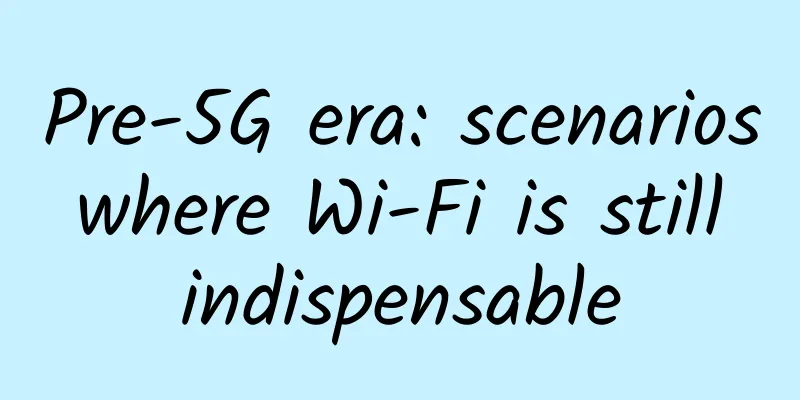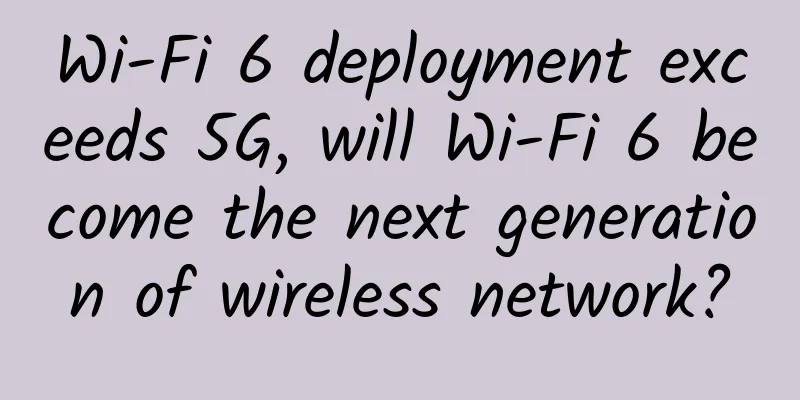Pre-5G era: scenarios where Wi-Fi is still indispensable

|
Recently, the concept of 5G technology has been hyped up. Thanks to the high-quality experience of 4G network, which has brought great imagination to mobile network users, some people have been saying that 5G will be the terminator of Wi-Fi even though 5G technology is still being gradually improved. After network service providers represented by AT&T launched unlimited mobile network services, Wi-Fi, which once "beat" wired network, seems to be unable to escape the fate of being crushed by new technology. Ruckus ZoneFlex R710, the industry's first 802.11ac Wave 2 access point with MU-MIMO support, supports up to four spatial streams and 500 concurrent users But what is the reality? The reason why a widely used technology is popular is that its value must not only be "making life more convenient"; judging from the development of information technology over the years, there are still many scenarios that cannot do without the strong support of Wi-Fi. Office Network After years of development, the office environment has increasingly clear requirements for the network: sufficient security and stability, cross-regional and cross-functional network coverage, centralized control, and sufficient scalability. Among these requirements, centralized control, scalability, and functional network division are the shortcomings of mobile cellular networks such as 4G and 5G, but they are the expertise of Wi-Fi. Nie Xiaoyun, technical manager of Ruckus Wireless (now Brocade NEBU department), told reporters that the wireless solution tailored for small and medium-sized enterprises can not only help enterprises easily obtain high-performance, high-reliability and high-scalability network systems, but also realize integrated and highly flexible management strategies - and it is extremely cost-effective. Generally speaking, an enterprise will have multiple public office areas, multiple conference rooms, and public reception rooms; different areas have completely different requirements for network control. Under the integrated network management strategy, it is necessary to divide the network access strategy and security strategy of different areas to reasonably utilize the limited network resources of the enterprise and ensure the security and reliability of key businesses. For example, a wired and wireless integrated network can be built for the core area to ensure the high-speed, stable and centralized management of business system communications; a large-capacity and comprehensive and stable WiFi network can be deployed for conference rooms and reception rooms to ensure dynamic access of each terminal while enjoying a more convenient and high-quality access experience; at the same time, the internal business flow and communication of the enterprise under a large local area network will also maintain a higher line speed level, effectively ensuring business efficiency. In the 4G era, we have seen that due to factors such as traffic and access stability, 4G networks in office environments will only be used as a supplement to the basic office network, such as remote office, encrypted single-point transmission of key data, etc. On the other hand, in a centralized office environment, high-density terminal access to the network will also put greater pressure on mobile base stations and reduce communication efficiency. This situation will not change fundamentally in the 5G era. Internet of Things and Smart Home In the past few years, we can clearly see that a large number of products in the Internet of Things, which aims to connect everything, use Wi-Fi as the main means of communication. According to statistics, in addition to mobile phones, 25% of consumer electronic devices use Wi-Fi, including printers and washing machines. The Home Appliance Manufacturers Association regards Wi-Fi as a higher-level smart appliance communication technology. Wi-Fi can connect devices to each other, thereby connecting the home appliances and electronic devices of the entire family. The demand in the smart home field can be seen as a microcosm of the Internet of Things. Industry insiders pointed out that homeowners who are renovating their homes or buying new houses now consider Wi-Fi in addition to water and electricity. More and more homeowners hope that home improvement companies and smart companies can provide wireless Wi-Fi solutions. Storage servers, security monitoring and other smart devices in smart homes are also controlled based on wireless Wi-Fi. Wi-Fi is the core carrier network for all family life and entertainment. There is reason to believe that Wi-Fi will continue to be a necessity for the entire family in the next 10 years. Smart City Recently, 16Wi-Fi, a well-known free public transport Wi-Fi provider, announced that it would stop operating in more than 20 cities including Tianjin. As the largest public transport Wi-Fi operator in China, 16Wi-Fi will stop serving cities including Guangzhou, Shanghai, Shenzhen, Foshan, Fuzhou, Tianjin, Changsha, Hangzhou, Haikou, Shaoxing and Kaifeng, leaving only Beijing and Kunming "as model cities". This event is considered by many to be an important sign that public Wi-Fi is about to exit. Is this really the case? Let's look at another piece of news. According to the latest news from foreign media, the Indian government has formulated a plan called "Digital Villages", which will invest 62 million US dollars to establish free Wi-Fi in more than 1,000 villages and provide villagers with mobile payment, remote medical consultation services and distance education opportunities. In addition, in the smart cities that have been widely built around the world in recent years, public Wi-Fi, which has always been the main low-cost or even free strategy, is still of great importance as the fifth public facility after water, electricity, gas and roads. This can also be seen from the actions and attitudes of wireless equipment providers and service providers in regional business. For example, Ruckus, a smart wireless network company, built a large number of public Wi-Fi-related infrastructure in Shenzhen, Shanghai, Dongguan, China, Sri Lanka and San Jose, USA in 2016. Solving the “last 50 meters” in the information age In urban planning, the concept of the last mile has been deeply rooted in people's minds - the market demand of reasonably connecting the main roads of the city with every household provides huge space for industrial development. The same problem also exists in the development of modern Internet. How to form an effective connection between the high-speed backbone network and the terminal also leaves a huge imagination space for the development of the Internet industry. Looking at the development history of Wi-Fi technology, long-distance transmission has always been a problem that Wi-Fi has not effectively solved. However, we can also see that within the effective transmission distance of about 50 meters, although there are a large number of competitors such as Bluetooth and infrared, Wi-Fi, which has reached the gigabit transmission level, is still our preferred solution with its high-quality performance and constantly evolving technology. There is reason to believe that the future WiFi and 5G will complement each other like the wired network and wireless network of the year, forming an organic complement. Just as the 4G to Wi-Fi product model that has been adopted in many solutions, mobile cellular networks can well solve the problem of regional network exit, and the optimal solution for small-scale coverage is given by Wi-Fi. For the last 50 meters, Wi-Fi will still have great potential. |
<<: It’s too early! The conditions for shutting down 2G networks may not be met until 2019
Recommend
SpeedyPage 10% off, starting from $4.83/month-AMD Ryzen, DDR5 memory, Gen4 NVMe, Ashburn computer room
SpeedyPage recently launched a high-performance V...
European operators can no longer bear the pressure as everyone stays at home. High-speed networks have become a powerful weapon in the fight against the epidemic
Netflix, Youtube, Disney+ and other video sites h...
India's 5G spectrum auction is imminent, but telecom operators are not responding
According to India's Economic Times, the Indi...
Is the future of the new WIFI standard 802.11ad reliable?
Now there is a new WIFI standard that can increas...
Understand the HTTP request process in one article. If you don't believe it, you still don't know it
Prerequisites OSI architecture TCP/IP related pro...
Teach you how to distinguish inferior cables
1. The harm of fake and inferior wires Electric w...
Campus "Full Wireless" Lets Data "Speak"
The construction of the campus network of Beijing...
In 2021, the development of 6G in various countries will accelerate, and the deployment of network satellites will become the focus.
Although 5G has only just become a reality, techn...
ZgoCloud: $14/quarter-AMD Ryzen9, 1GB memory, 30G NVMe, Osaka, Japan data center
ZgoCloud domain name registration started in Apri...
Fairytale Town: $4.19/month KVM-1GB/10G SSD/1TB/Japan Data Center
Fairytale Town is a Chinese hosting company estab...
Availability monitoring tool for large networks
[[184858]] No enterprise can live without network...
Gcore (gcorelabs) Japanese VPS simple test
The tribe has shared G-core product information s...
The strength of the WiFi signal is related to this core factor. Don't get it wrong.
When buying a wireless router, you should buy one...
Inventory of URLError and HTTPError exception handling methods
[[390611]] 1. Introduction This article mainly ta...
2019 Global Trend Conference 5G Ecosystem Cooperation Forum 5G era brings infinite imagination to the future
From November 28th to 29th, the "2019 Global...









